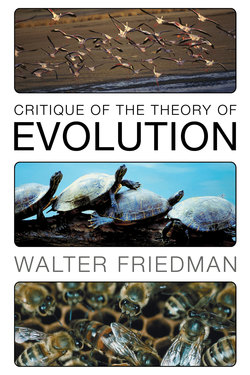Читать книгу Critique of the Theory of Evolution - Walter Friedman - Страница 12
На сайте Литреса книга снята с продажи.
7 : The Original Cell as an Entity That Cannot Possibly Exist
ОглавлениеEvolutionists believe that an as yet unknown chemical reaction turned inorganic matter into a DNA-like structure called the original cell. This transformation, they say, occurred millions of years ago. So far, however, nobody has been able to reproduce the reaction and there are no theoretical considerations showing that such a transformation is possible. In fact, the exact opposite is true—theoretically, it is impossible for this kind of transformation to occur. The proof is presented in Appendix B of this book. Unfortunately, the proof is extremely complicated and requires considerable knowledge of atomic physics; for this reason it has been placed outside the main body of the text.
There is yet another angle of attack on the concept of the original cell that requires only a moderate, high-school-level knowledge of physics and chemistry.
We’ll start with comparing modern geophysical conditions with the conditions that caused the creation of the purported original cell. According to the cosmological theories, Earth was much hotter those days and the original cell’s natural habitat, the ocean, was heated almost to the boiling point, with the highest temperature at the seabed where volcanic activity was affecting the earth’s crust. Another noticeable difference was high-intensity bombardment of the planet with alpha-particles, gamma-particles, and beta-particles. All these primordial conditions could be easily reproduced in a physics laboratory. In fact, these conditions are present in one form or another in elementary particle accelerators. But physicists also know that alpha-, beta-, and gamma-particles produce unstable configurations (matter) that disintegrate into original components in a fraction of a second. This means that all cosmological theories indicate that the original cell could not possibly exist.
American astrophysicist Carl Sagan tried to circumvent this difficulty by proposing the theory that a spore of unknown vegetation from an unknown place (was it the Planet of the Apes?) somehow got into outer space, then, while being pushed by solar winds, traveled for trillion of years and finally hit the earth, accomplishing what the original cell failed to do.
Sagan knew physics—there’s no doubt about that—but he had no knowledge of genetics; otherwise, he would have known that the “Sagan spore,” being a single parent, would have left its genetic imprint on all of the earth’s organisms (see chapter 6 of this book).
What if it were possible to design an experiment that would prove once and for all that the evolutionary theory is incorrect? Actually, such an experiment can be designed—it is based on the notion of an ecosystem. This is how Webster’s New World Dictionary defines ecosystem: “a system made up of a community of animals, plants and bacteria and its interrelated physical and chemical environment.”
What would be the single most important characteristic vital to the survival of a species? That would be the ability to live outside of an ecosystem. Such an ability also implies the ability to live within any partially developed ecosystem. The original cell was all by itself; there was no ecosystem to support it. If the evolutionary theory is correct, all organisms, past and present, should have inherited its ability to live outside the ecosphere.
The idea for this experiment is simple: it would require only a large aquarium filled with seawater and rock formations and a single specimen of fish, bacteria, or seaweed that would normally inhabit such an environment. Can it support itself outside the ecosystem? Other than coral reefs, no one can exist in such an environment for long.
This experiment is the foundation of science; it shows that the evolutionary theory is anything but science.
